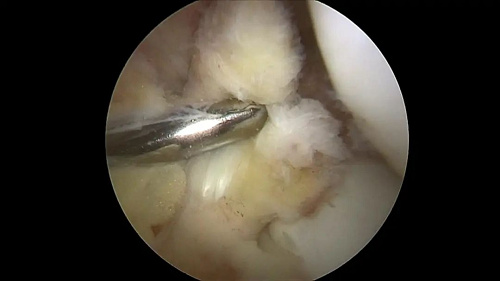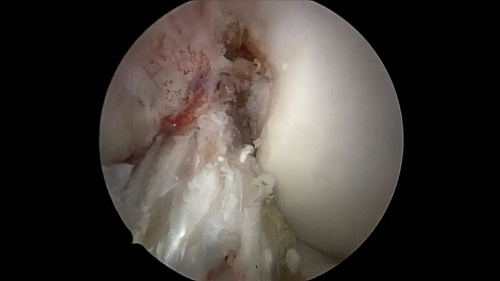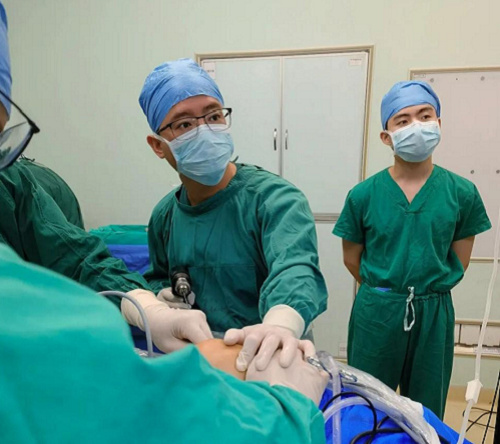Jack, a 22-year-old football enthusiast, plays football with his friends every week, and football has become an indispensable part of his daily life. Last weekend when playing football, Zhang accidentally slipped and fell, so painful that he could not stand up, unable to walk, after a few days of recuperation at home or pain, unable to stand, was sent to the orthopaedic department of the hospital by a friend, the physician received the examination and improve the knee MRI, diagnosed as the anterior cruciate ligament femoral side of the fracture, the need for hospitalisation for minimally invasive arthroscopic surgical treatment.
After completing the preoperative examinations, the doctors formulated a precise treatment plan for Jack's condition, and decided to rebuild the ACL with the minimally invasive arthroscopic technique using autologous popliteal tendon after full communication with Jack. On the second day after the operation, he was able to go down to the ground and his knee pain symptoms were significantly relieved. After systematic training, Jack will soon be able to return to the field.

Complete rupture of the femoral side of the anterior cruciate ligament seen microscopically

Anterior cruciate ligament after reconstruction with autologous hamstring tendon

Doctor gives patient minimally invasive arthroscopic ligament reconstruction surgery
The anterior cruciate ligament (ACL) is one of two ligaments that cross at the middle of the knee, connecting the thigh bone to the calf bone and helping to stabilise the knee joint. ACL injuries occur most often in sports that require sharp stops or sudden changes of direction, jumping and landing, such as football, basketball, rugby and downhill skiing. Typical presentations include sudden, severe pain and audible popping. When an ACL injury occurs, many people hear a "click" in the knee or feel a crack in the knee. The knee may swell, feel unstable, and have difficulty supporting your weight because of the pain.
In recent years, ACL injuries have become a prevalent sports injury with an increased focus on healthy exercise. The methods to diagnose this injury include: history taking, physical examination, and imaging examination. MRI is currently the most important imaging method for ACL injuries nowadays, and the accuracy of MRI examination in the acute stage is more than 95%.
Rupture of the ACL affects the stability of the knee joint, resulting in imbalance and wobbling when the joint flexes, extends and rotates, and after a period of time, it often causes meniscus and cartilage injuries. At this time, there will be knee pain, limited range of motion or even suddenly "stuck", can not move the feeling, which means that the injury is not light, even if you do surgery to repair than the early injury repair is difficult, the effect is also relatively poor. Many of the changes caused by knee instability, such as meniscus damage, osteophytes, cartilage wear, etc., are irreversible, leading to a series of sequelae, and also increase the cost of treatment. Therefore, arthroscopic anterior cruciate ligament reconstruction is highly recommended after ACL injury, to restore the stability of the knee joint.
What are the symptoms of ACL injury?
The primary function of the ACL is to limit the anterior displacement of the tibia and maintain its rotational stability. After an ACL rupture, the tibia will move forward spontaneously, and the patient may feel unstable and wobbly in daily walking, sports or rotational activities, and sometimes feel that the knee is not able to use its strength and is weak.
The following symptoms are common with ACL injuries:
①Knee pain, located in the joint, patients may be afraid to move due to severe pain, some patients can walk or continue low-intensity exercise due to mild pain.
② knee swelling, due to intra-articular haemorrhage caused by the knee joint, usually occurs within minutes to hours after the knee injury.
Restriction of knee extension, ligament rupture ligament stump turned to the intercondylar fossa anterior to produce inflammatory irritation. Some patients may have limited extension or flexion due to meniscus injury. Combined with medial collateral ligament injury, sometimes it is also manifested as limitation of extension.
Knee instability, some patients feel the wrong movement in the knee joint at the time of injury, and start to feel the wobbling sensation of the knee joint (i.e. the feeling of dislocation between the bones as described by the patients) when resuming walking about 1-2 weeks after the injury.
⑤ Limited mobility of the knee joint, caused by traumatic synovitis resulting in swelling and pain in the knee joint.
The doctor introduced that arthroscopic anterior cruciate ligament reconstruction is aimed at repairing the anterior cruciate ligament after rupture, and the current mainstream treatment is arthroscopic transplantation of a tendon into the knee joint to rebuild a new ligament, which is a minimally invasive procedure. The transplanted tendon is preferred to autologous popliteal tendon, which has the advantages of less traumatic incision, less impact on function, no rejection, and easy tendon bone healing. Patients with smooth postoperative rehabilitation procedures walk on crutches in January, off crutches in February, walk with the support removed in March, return to general sports in six months, and return to their pre-injury level of sports in one year.
Post time: May-14-2024










